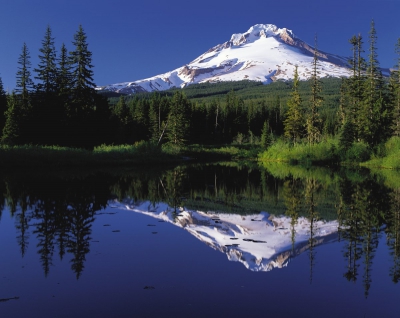Samuel Hood, 1st Viscount Hood (12 December 1724 27 January 1816) was an admiral in the Royal Navy. As a junior officer he saw action during the War of the Austrian Succession. While in temporary command of Antelope, he drove a French ship ashore in Audierne Bay, and captured two privateers in 1757 during the Seven Years' War. He held senior command as Commander-in-Chief, North American Station and then as Commander-in-Chief, Leeward Islands Station, leading the British fleet to victory at Battle of the Mona Passage in April 1782 during the American Revolutionary War. He went on to be Commander-in-Chief, Portsmouth, then First Naval Lord and, after briefly returning to the Portsmouth command, became Commander-in-Chief, Mediterranean Fleet during the French Revolutionary Wars. His younger brother was Admiral Alexander Hood, 1st Viscount Bridport (17261814), and his first cousin once-removed was Admiral Sir Samuel Hood, 1st Baronet (17621814).
Mount Hood is a potentially active stratovolcano in the Cascade Volcanic Arc. It was formed by a subduction zone on the Pacific coast and rests in the Pacific Northwest region of the United States. It is located about 50 miles (80 km) east-southeast of Portland, on the border between Clackamas and Hood River counties. In addition to being Oregon's highest mountain, it is one of the loftiest mountains in the nation based on its prominence, and it offers the only year-round lift-served skiing in North America.
The height assigned to Mount Hood's snow-covered peak has varied over its history. Modern sources point to three different heights: 11,249 feet (3,429 m), a 1991 adjustment of a 1986 measurement by the U.S. National Geodetic Survey (NGS), 11,240 feet (3,426 m) based on a 1993 scientific expedition, and 11,239 feet (3,425.6 m) of slightly older origin. The peak is home to 12 named glaciers and snowfields. It is the highest point in Oregon and the fourth highest in the Cascade Range.
Mount Hood is considered the Oregon volcano most likely to erupt,
though based on its history, an explosive eruption is unlikely. Still, the odds of an eruption in the next 30 years are estimated at between 3 and 7%, so the U.S. Geological Survey (USGS) characterizes it as "potentially active", but the mountain is informally considered dormant.

1792Oct, 29
Mount Hood (Oregon) is named after Samuel Hood, 1st Viscount Hood by Lt. William E. Broughton who sighted the mountain near the mouth of the Willamette River.
Choose Another Date
Events on 1792
- 20Feb
United States Postal Service
The Postal Service Act, establishing the United States Post Office Department, is signed by United States President George Washington. - 5Apr
Veto
United States President George Washington exercises his authority to veto a bill, the first time this power is used in the United States. - 20Apr
French Revolutionary Wars
France declares war against the "King of Hungary and Bohemia", the beginning of French Revolutionary Wars. - 21Apr
Hanged, drawn and quartered
Tiradentes, a revolutionary leading a movement for Brazil's independence, is hanged, drawn and quartered. - 28Apr
French Revolutionary Wars
France invades the Austrian Netherlands (present day Belgium and Luxembourg), beginning the French Revolutionary Wars.

 English
English  español
español  français
français  português
português  русский
русский  العربية
العربية  简体中文
简体中文 